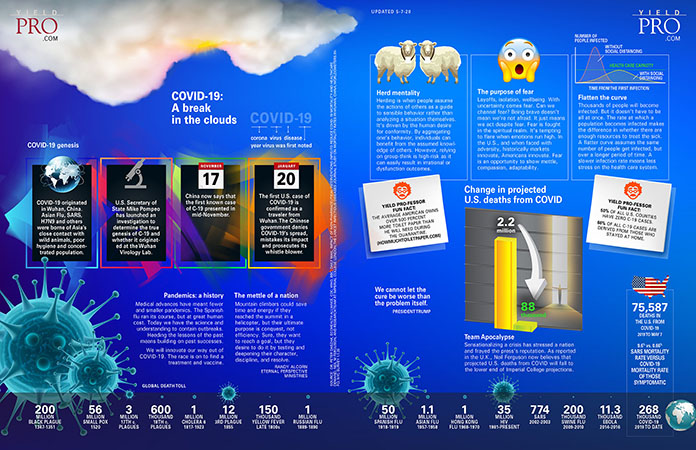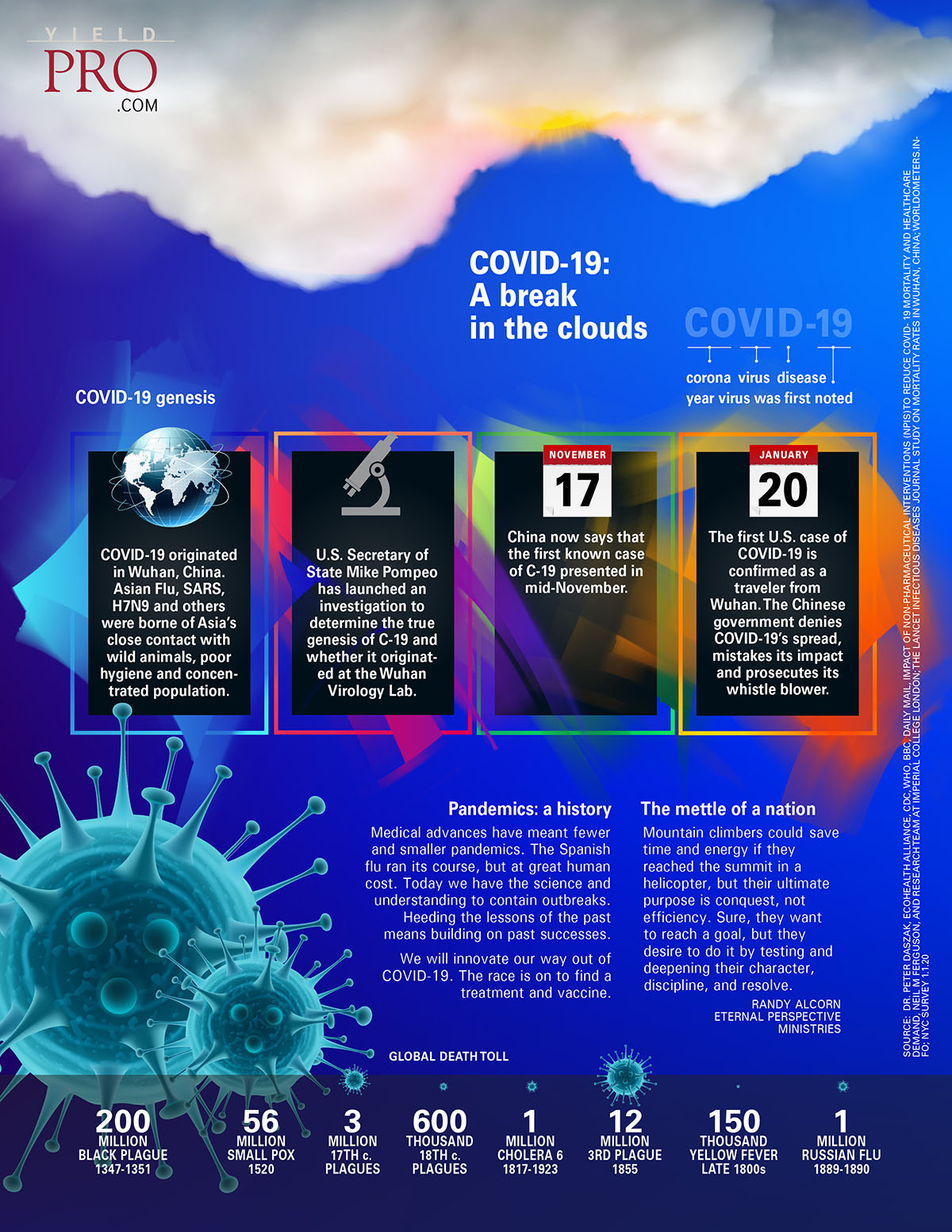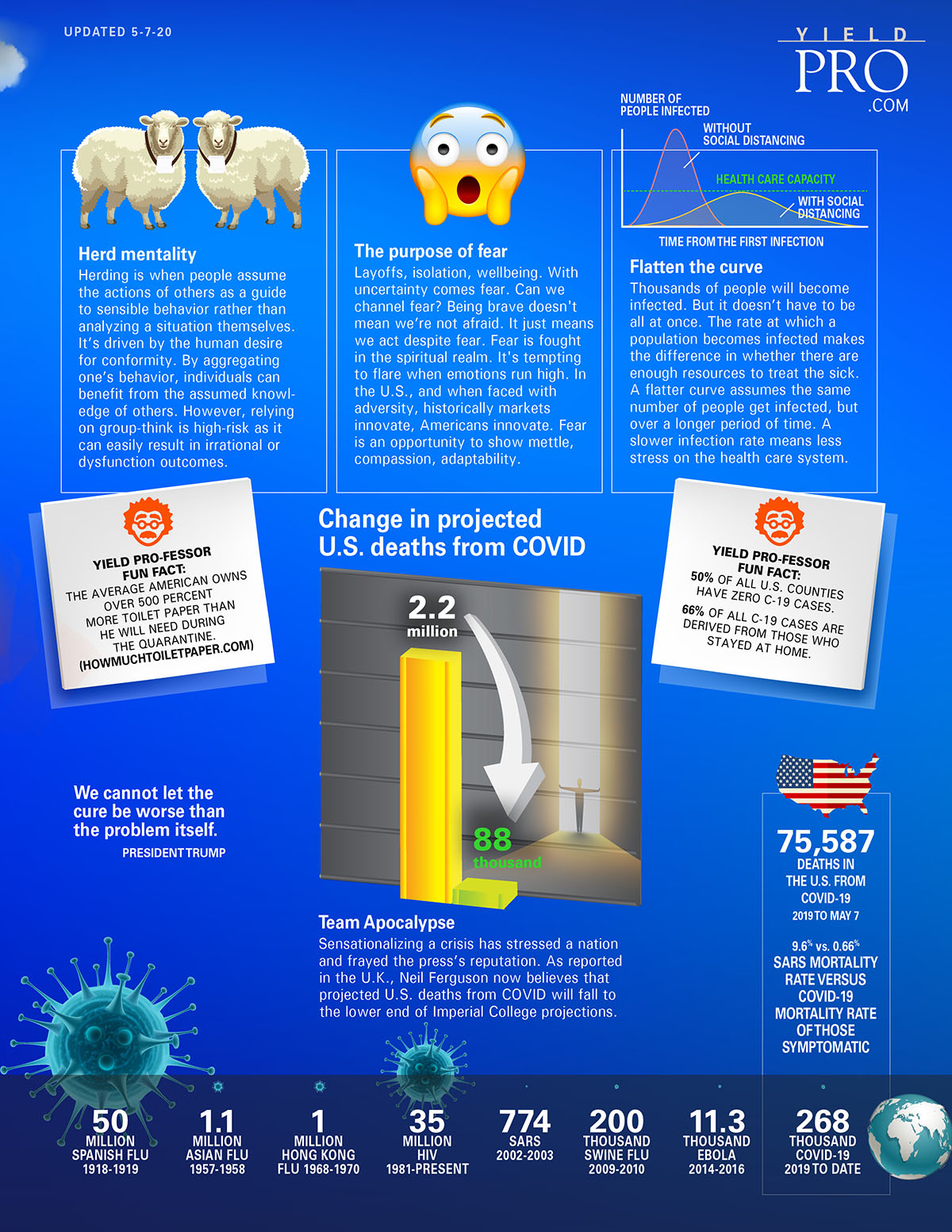UPDATED: MAY 7, 2020
COVID-19 genesis
COVID-19 originated in Wuhan, China. Asian Flu, SARS, H7N9 and others were borne of Asia’s close contact with wild animals, poor hygiene and concentrated population.
It‘s thought that COVID-19 was passed to humans from bats via pangolins, a mammal highly prized in traditional Chinese medicine.
Patient zero exhibits symptoms. Days later his wife presents pneumonia. Week 2: Wuhan doctors note explosion in similar cases. Whistleblower doctor Li Wenliang warns of outbreak.
The first U.S. case of COVID-19 is confirmed as a traveler from Wuhan. The Chinese government denies COVID-19’s spread, mistakes its impact and prosecutes the whistle blower.
Pandemics: a history
Medical advances have meant fewer and smaller pandemics. The Spanish flu ran its course, but at great human cost. Today we have the science and understanding to contain outbreaks. Heeding the lessons of the past means building on past successes.
We will innovate our way out of COVID-19. The race is on to find a treatment and vaccine.
- 200 million Black Plague 1347-1351
- 56 million Smallpox 1520
- 3 million 17th c. Plagues
- 600 thousand 18th c. Plagues
- 1 million Cholera 6 1817-1923
- 12 million 3rd Plague 1855
- 150 thousand Yellow Fever late 1800s
- 1 million Russian Flu 1889-1890
- 50 million Spanish Flu 1918-1919
- 1.1 million Asian Flu 1957-1958
- 1 million Hong Kong Flu 1968-1970
- 35 million HIV 1981-present
- 774 SARS 2002-2003
- 200 thousand Swine Flu 2009-2010
- 11.3 thousand Ebola 2014-2016
- 75,587 deaths in the U.S. from COVID-19 2019 to May 7
- 9.6% vs. 0.66% SARS mortality rate versus COVID-19 mortality rate of those symptomatic
- 268,000 COVID-19 2019 to date
The mettle of a nation
Mountain climbers could save time and energy if they reached the summit in a helicopter, but their ultimate purpose is conquest, not efficiency. Sure, they want to reach a goal, but they desire to do it by testing and deepening their character, discipline, and resolve.
Randy Alcorn Eternal Perspective Ministries
Herd mentality
Herding is when people assume the actions of others as a guide to sensible behavior rather than analyzing a situation themselves. It’s driven by the human desire for conformity. By aggregating one’s behavior, individuals can benefit from the assumed knowledge of others. However, relying on group-think is high-risk as it can easily result in irrational or dysfunction outcomes.
The purpose of fear
Layoffs, isolation, wellbeing. With uncertainty comes fear. Can we channel fear? Being brave doesn’t mean we’re not afraid. It just means we act despite fear. Fear is fought in the spiritual realm. It’s tempting to flare when emotions run high. In the U.S., and when faced with adversity, historically markets innovate, Americans innovate. Fear is an opportunity to show mettle, compassion, adaptability.
Flatten the curve
Thousands of people will become infected. But it doesn’t have to be all at once. The rate at which a population becomes infected makes the difference in whether there are enough resources to treat the sick. A flatter curve assumes the same number of people get infected, but over a longer period of time. A slower infection rate means less stress on the health care system.
YIELD PRO-FESSOR FUN FACT:
The average American owns over 500 percent more toilet paper than he will need during the quarantine. (howmuchtoiletpaper.com)
YIELD PRO-FESSOR FUN FACT:
COVID-19 is more transmissible than thought. But because strong measures have been taken deaths will be closer to lower projections. Neil Ferguson, epidemiologist, Imperial College London
We cannot let the cure be worse than the problem itself. President Trump
Team Apocalypse
Sensationalizing a crisis has stressed a nation and frayed the press’s reputation. As reported in the U.K., Neil Ferguson now believes that projected U.S. deaths from COVID will fall to the lower end of Imperial College projections.

















